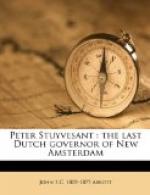In the summer of 1679, but five years after the final accession of New Netherland by the English, two gentlemen from Holland, as the committee of a religious sect, visited the Hudson river, to report respecting the condition of the country, and to select a suitable place for the establishment of a colony. They kept a minute journal of their daily adventures. From their narrative one can obtain a very vivid picture of New York life two hundred years ago.
On Saturday, the 23d day of September, they landed at New York, and found it a very strange place. A fellow passenger, whose name was Gerritt, and who was on his return from Europe, resided in New York. He took the travellers to the house of one of his friends, where they were regaled with very luscious peaches, and apples far better than any they had seen in Holland. They took a walk out into the fields and were surprised to see how profusely the orchards wore laden with fruit. They took up lodgings with the father-in-law of their fellow-traveller, and in the evening were regaled with rich milk. The next day was Sunday.
“We walked awhile,” they write,
“in the pure mountain air, along the margin of the clear running water of the sea, which is driven up this river at every tide. We went to church and found truly there a wild worldly people. I say wild, not only because the people are wild, as they call it in Europe, but because most all the people who go there, partake somewhat of the nature of the country; that is peculiar to the land where they live.”
The preacher did not please them. “He used such strange gestures and language,” writes one of them, “that I think I never in my life heard anything more miserable. As it is not strange in these countries, to have men as ministers, who drink, we could imagine nothing else than that he had been drinking a little this morning. His text was Come unto me all ye, etc.; but he was so rough that the roughest and most godless of our sailors were astonished.
“The church being in the fort, we had an opportunity to look through the latter, as we had come too early for preaching. The fort is built upon the point formed by the two rivers, namely the East river, which is the water running between the Manhattans and Long Island, and the North river, which runs straight up to fort Orange. In front of the fort there is a small island called Nut Island. Around the point of this vessels must sail in going out or in, whereby they are compelled to pass close by the point of the fort, where they can be flanked by several of the batteries. It has only one gate and that is on the land side, opening upon a broad lane or street, called the Broadway.”
They went to church again in the afternoon. “After preaching,” they write,




